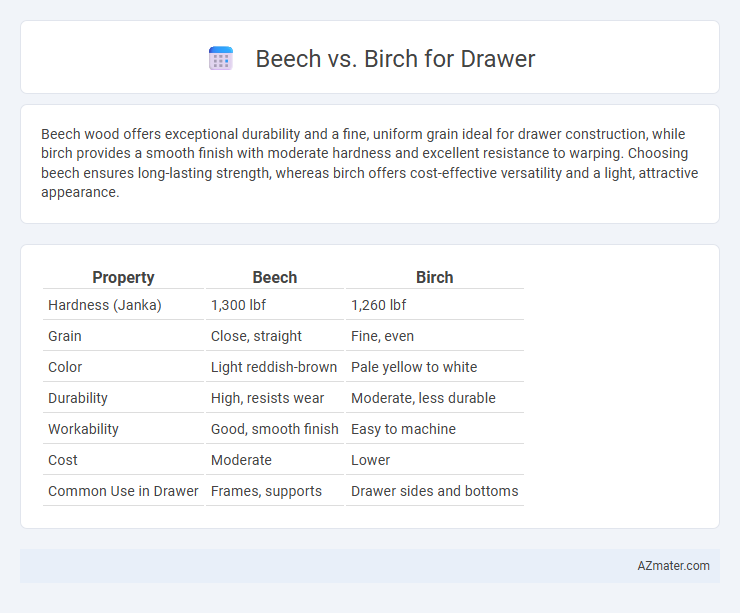Beech wood offers exceptional durability and a fine, uniform grain ideal for drawer construction, while birch provides a smooth finish with moderate hardness and excellent resistance to warping. Choosing beech ensures long-lasting strength, whereas birch offers cost-effective versatility and a light, attractive appearance.
Table of Comparison
| Property | Beech | Birch |
|---|---|---|
| Hardness (Janka) | 1,300 lbf | 1,260 lbf |
| Grain | Close, straight | Fine, even |
| Color | Light reddish-brown | Pale yellow to white |
| Durability | High, resists wear | Moderate, less durable |
| Workability | Good, smooth finish | Easy to machine |
| Cost | Moderate | Lower |
| Common Use in Drawer | Frames, supports | Drawer sides and bottoms |
Introduction: Beech vs Birch for Drawer Construction
Beech and birch are both durable hardwoods commonly used in drawer construction, offering distinct grain patterns and hardness levels. Beech features a fine, tight grain with a smooth finish, making it ideal for high-quality cabinetry that demands strength and aesthetic appeal. Birch provides a slightly softer texture with a lighter color, often chosen for its affordability and ease of machining in drawer manufacturing.
Wood Anatomy: Beech and Birch Characteristics
Beech wood features a tight, consistent grain with a fine, even texture, making it ideal for smooth drawer surfaces and durability. Birch wood exhibits a slightly coarser grain with a uniform texture, known for its strength and resistance to wear in furniture construction. Both species offer light coloration, but Beech typically has a more reddish hue while Birch tends toward creamy white, influencing drawer aesthetics and finishing options.
Durability and Strength Comparison
Beech wood offers exceptional durability and resistance to dents, making it ideal for drawers that require frequent handling and long-term use. Birch wood provides comparable strength but is generally softer and more prone to surface damage under heavy wear. For drawer construction, beech is preferred for its superior hardness and ability to maintain structural integrity over time.
Appearance and Grain Patterns
Beech wood features a pale, creamy color with a fine, straight grain that offers a smooth and uniform appearance, making it ideal for drawers requiring a clean, minimalist look. Birch wood presents a slightly deeper tone with a more pronounced grain pattern, including subtle waves and occasional curls, which adds character and visual interest to drawer surfaces. Both woods provide durability, but birch drawers stand out for their distinctive, decorative grain, whereas beech draws attention for consistent texture and lightness in color.
Workability: Machining, Cutting, and Finishing
Beech offers excellent workability with smooth machining, easy cutting, and a fine finish, making it ideal for drawer construction. Birch also provides good machining and cutting characteristics but tends to be slightly harder, requiring sharper tools for clean edges. Both woods accept finishing well, although Beech's uniform grain results in a more consistent, polished appearance.
Cost and Availability of Beech and Birch
Beech wood is generally more affordable and widely available compared to birch, making it a popular choice for drawer construction in budget-conscious projects. Birch offers a slightly higher price point due to its fine grain and smooth finish but can be less readily found in some regions. Both woods provide good workability and durability, yet availability and cost often make beech the preferred option for large-scale or cost-sensitive furniture manufacturing.
Environmental Impact and Sustainability
Beech and birch wood both offer sustainable options for drawer construction, but beech is favored for its faster growth rate and higher yield per hectare, resulting in a lower environmental footprint. Birch typically comes from cooler climates with slower tree maturity, which can increase the environmental cost due to longer cultivation periods. Both woods are biodegradable and recyclable, but sourcing beech from certified sustainable forests ensures minimized deforestation and supports responsible forestry practices.
Moisture Resistance and Stability in Drawers
Beech wood offers excellent stability and moderate moisture resistance, making it suitable for drawer construction where dimensional consistency is crucial. Birch is also stable but tends to absorb more moisture than beech, increasing the risk of swelling or warping in humid environments. For durability and maintaining drawer integrity, beech is often preferred due to its tighter grain and better resistance to moisture-related changes.
User Preferences and Real-World Applications
Beech wood offers a smooth texture and durability ideal for modern drawer construction, favored by users seeking a sleek finish and resistance to wear. Birch provides a lighter color and fine grain, appealing to those who prefer a natural aesthetic and easy customization through staining or painting. In real-world applications, beech is preferred in high-traffic environments like kitchens due to its sturdiness, while birch is commonly used in decorative drawers and furniture requiring detailed craftsmanship.
Conclusion: Choosing the Best Wood for Drawers
Beech offers greater durability and resistance to wear, making it ideal for drawers subject to frequent use, while birch provides a lighter appearance with smooth grain, suitable for decorative drawers. Beech's hardness ensures long-lasting strength and stability, whereas birch's affordability and ease of finishing make it a cost-effective alternative. Selecting between beech and birch depends on balancing durability needs against aesthetic preferences and budget constraints.

Infographic: Beech vs Birch for Drawer
 azmater.com
azmater.com